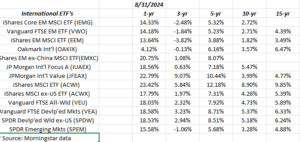It’s a crude summary using an Excel spreadsheet, but this blog has been tracking the annual returns of the international funds and ETFs as the asset class looked more and more grim the last few years
That being said, international looks to be starting to stir.
As was noted in the Top 10 client holdings over the weekend, current longs are the Oakmark International Fund (OAKIX), which is being reduced, the Emerging Markets ex-China ETF (EMXC), the Vanguard FTSE Developed Markets ETF (VEA), and the JP Morgan Developed Int’l Value (JFEAX), of which a position is being built as of the last few weeks.
What caught my eye as the spreadsheet was updated was the 1-year returns on the pure international vehicles (i.e. no US holdings of any size), are starting to put up some healthy returns as are the non-China emerging markets (like the EMXC). Compare the EMXC return to both VEO and EEM, both of which are Vanguard international ETF’s that mirror the China weight in the international benchmark, which is somewhere around 33%, and you’ll see that the emerging markets outside China are generating nice returns.
Watch how the US dollar responds to fed funds rate reductions. A weakening of the dollar will help the international equity and bond asset classes, bonds even more so since the dollar represents a bigger portion of the international fixed-income return.
I’m sure it’s tiring listening to historical periods like the rotation into international after the growth stock and tech stocks popped in March, 2000, but that’s exactly what happened. International was dead money for the 5 years from 1995 – 1999, as were commodities, and anything that wasn’t US, growth and tech, and then those asset classes came roaring back with a vengeance.
History may not mirror itself exactly, but investors should see a period where international outperforms, even US markets.
Look at the 10-year returns of the pure international mutual funds and ETF’s (ACWI has a US component): don’t they seem pretty paltry relative to the SPY’s 10-year annual return of +12.88% and the QQQ’s +17.88% ?
None of this is advice or a recommendation, but only an opinion. Past performance is no guarantee of future results. Investing can and does involve loss of principal even for short periods of time.
Thanks for reading.

